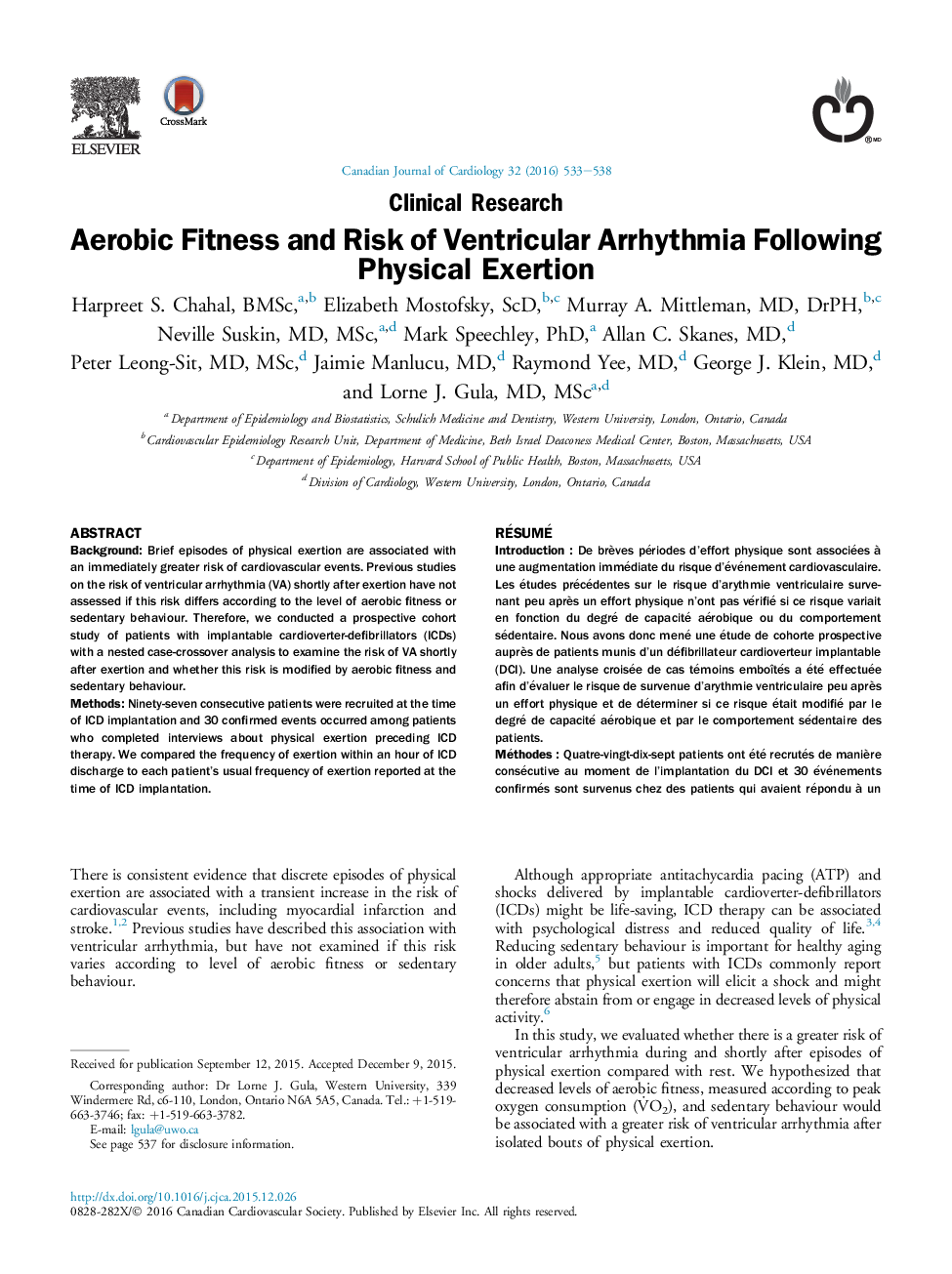| کد مقاله | کد نشریه | سال انتشار | مقاله انگلیسی | نسخه تمام متن |
|---|---|---|---|---|
| 2727144 | 1566486 | 2016 | 6 صفحه PDF | دانلود رایگان |
BackgroundBrief episodes of physical exertion are associated with an immediately greater risk of cardiovascular events. Previous studies on the risk of ventricular arrhythmia (VA) shortly after exertion have not assessed if this risk differs according to the level of aerobic fitness or sedentary behaviour. Therefore, we conducted a prospective cohort study of patients with implantable cardioverter-defibrillators (ICDs) with a nested case-crossover analysis to examine the risk of VA shortly after exertion and whether this risk is modified by aerobic fitness and sedentary behaviour.MethodsNinety-seven consecutive patients were recruited at the time of ICD implantation and 30 confirmed events occurred among patients who completed interviews about physical exertion preceding ICD therapy. We compared the frequency of exertion within an hour of ICD discharge to each patient's usual frequency of exertion reported at the time of ICD implantation.ResultsWithin an hour of episodes of exertion, the risk of VA was 5.3 (95% confidence interval [CI], 2.7-10.6) times greater compared with periods of rest. The association was higher among patients with aerobic fitness below the median (relative risk [RR] = 17.5; 95% CI, 5.2-58.5) than for patients with aerobic fitness above the median (RR, 1.2; 95% CI, 0.4-4.2; P homogeneity = 0.002) and higher among patients who were sedentary (RR, 52.8; 95% CI, 10.1-277) compared with individuals who were not sedentary (RR, 3.2; 95% CI, 1.3-7.6; P homogeneity = 0.0002).ConclusionsWithin 1 hour of episodes of exertion, there is an increased risk of VA, especially among individuals with lower levels of aerobic fitness and with sedentary behaviour.
RésuméIntroductionDe brèves périodes d’effort physique sont associées à une augmentation immédiate du risque d’événement cardiovasculaire. Les études précédentes sur le risque d’arythmie ventriculaire survenant peu après un effort physique n’ont pas vérifié si ce risque variait en fonction du degré de capacité aérobique ou du comportement sédentaire. Nous avons donc mené une étude de cohorte prospective auprès de patients munis d’un défibrillateur cardioverteur implantable (DCI). Une analyse croisée de cas témoins emboîtés a été effectuée afin d’évaluer le risque de survenue d’arythmie ventriculaire peu après un effort physique et de déterminer si ce risque était modifié par le degré de capacité aérobique et par le comportement sédentaire des patients.MéthodesQuatre-vingt-dix-sept patients ont été recrutés de manière consécutive au moment de l’implantation du DCI et 30 événements confirmés sont survenus chez des patients qui avaient répondu à un questionnaire sur l’effort physique avant l’implantation du DCI. Nous avons comparé la fréquence de l’effort physique dans un délai d’une heure de la décharge du DCI à la fréquence habituelle de l’effort physique indiquée par le patient au moment de l’implantation du DCI.RésultatsDans l’heure qui suivait l’effort physique, le risque d’arythmie ventriculaire était 5,3 fois supérieur (intervalle de confiance [IC] à 95 %, de 2,7 à 10,6) par rapport aux périodes de repos. Ce lien était plus important chez les patients dont la capacité aérobique était sous la médiane (risque relatif [RR] = 17,5; IC à 95 %, de 5,2 à 58,5) que chez les patients dont la capacité aérobique était supérieure à la médiane (RR = 1,2; IC à 95 %, de 0,4 à 4,2; valeur p d’homogénéité = 0,002), et il était supérieur chez les patients sédentaires (RR = 52,8; IC à 95 %, de 10,1 à 277) par rapport aux patients actifs physiquement (RR = 3,2; IC à 95 %, de 1,3 à 7,6; valeur p d’homogénéité = 0,0002).ConclusionsIl y a accroissement du risque d’arythmie ventriculaire dans un délai d’une heure suivant un effort physique, particulièrement chez les patients sédentaires et ceux qui ont une capacité aérobique moindre.
Journal: Canadian Journal of Cardiology - Volume 32, Issue 4, April 2016, Pages 533–538
